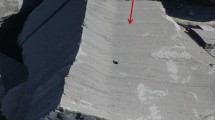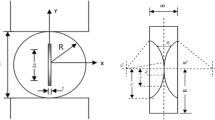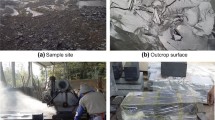Abstract
The intersection of fractures, particularly the intersection of discontinuities, occurs frequently in practical engineering, mainly manifesting as a mixed-mode failure. In the present study, the three-point bend test was conducted on the semicircular bend (SCB) of pre-cracked shale samples with a bedding layer. A numerical model for simulating mixed-mode fracture propagation was constructed using the extended finite element method. The minimum strain energy density criterion was applied for crack initiation and propagation. According to the experimental results, the minimum strain energy density criterion better indicates the fracture path. When the approach angle was set at 30°, the mode I fracture toughness was 0.85 MPa m1/2 and the mode II fracture toughness was 0.38 MPa m1/2. Furthermore, the mixed-mode fracture path and the crack initiation angle of the SCB with a bedding layer were discussed. As the approach angle became smaller and more prone to crack propagation, a tendency for the fracture propagation path to transfer to the fracture diversion was observed. If the Young's modulus of the layer is greater than the Young's modulus of the shale, the propagation path of the fracture would be far away from the layer. With the decrease in the tensile strength of the bedding layer, the fracture was more likely to propagate along the bedding layer orientation. The present study aimed to better understand the crack initiation and expansion in the mixed-mode fracture process with a bedding layer.












Similar content being viewed by others
Abbreviations
- a :
-
Crack length
- β :
-
Crack approach angle
- B :
-
Specimen thickness
- CCNBD:
-
Cracked chevron-notched Brazilian disc
- CNB:
-
Cut notched bend
- D:
-
Specimen diameter
- K :
-
Stress intensity factor
- K IC :
-
Fracture toughness
- K I :
-
Mode I stress intensity factor
- KgI I :
-
Mode II stress intensity factor
- K I II :
-
Mode III stress intensity factor
- K 1C :
-
Mode I fracture toughness
- K 2C :
-
Mode II fracture toughness
- R :
-
Specimen radius
- Rs:
-
Saw radius
- P :
-
Load on specimen
- S :
-
Strain energy density factor
- SCB:
-
Semicircular bend
- SR:
-
Short rod
- t :
-
Notch width
- W :
-
Strain energy density
- Y*:
-
Minimum value of the dimensionless stress intensity factor
- Y1 :
-
The dimensionless parameter
- Y2 :
-
The dimensionless parameter
- r :
-
The radius
- u :
-
Parameter depends on α0 and αB
- ν :
-
Parameter depends on α0 and αB
References
Wang, D.; Bian, X.; Qin, H.; Sun, D.; Bo, Yu.: Experimental investigation of mechanical properties and failure behavior of fluid-saturated hot dry rocks. Nat. Resour. Res. (2020). https://doi.org/10.1007/s11053-020-09760-x
Guo, T., et al. Physical simulation of hydraulic fracturing of large-sized tight sandstone outcrops. SPE J. 2020.
He, Y., et al.: Improving oil recovery through fracture injection and production of multiple fractured horizontal wells. J. Energy Resour. Technol. 142(5), 053002 (2020)
Wang, D.; Dong, Y.; Sun, D.; Bo, Yu.: A three-dimensional numerical study of hydraulic fracturing with degradable diverting materials via CZM-based FEM. Eng. Fract. Mech. 237, 107251 (2020). https://doi.org/10.1016/j.engfracmech.2020.107251
Li, Y., et al.: A rock physics model for the characterization of organic-rich shale from elastic properties. Pet. Sci. 12(2), 264–272 (2015)
Liu, S.; Zhang, D.; Liu, H.: Rock crack propagation mechanism of oriented perforation hydraulic fracture under different perforation parameters. Arab. J. Sci. Eng. 45(10), 8711–8725 (2020)
Guo, Y., et al.: Study on the influence of bedding density on hydraulic fracturing in shale. Arab. J. Sci. Eng. 43(11), 6493–6508 (2018)
Li, Y., et al.: Experimental of hydraulic fracture propagation using fixed-point multistage fracturing in a vertical well in tight sandstone reservoir. J. Pet. Sci. Eng. 171, 704–713 (2018)
Warpinski, N.; Teufel, L.: Influence of geologic discontinuities on hydraulic fracture propagation (includes associated papers 17011 and 17074). J. Pet. Technol. 39, 209–220 (1987)
Zhang, X.; Jeffrey, R.G.; Thiercelin, M.: Deflection and propagation of fluid-driven fractures at frictional bedding interfaces: a numerical investigation. J. Struct. Geol. 29, 396–410 (2007)
Gu, H.; Weng, X.; Lund, J.B.; Mack, M.G.; Ganguly, U.; Suarez-rivera, R.: Hydraulic fracture crossing natural fracture at non-orthogonal angles, a criterion, its validation and applications. SPE Hydraulic Fracturing Technology Conference, 2011. Society of Petroleum Engineers (2011).
Lamont, N.; Jessen, F.: The effects of existing fractures in rocks on the extension of hydraulic fractures. J Pet Technol 15, 203–209 (1963)
Daneshy, A.A.: Hydraulic fracture propagation in the presence of planes of weakness. SPE European spring meeting. Society of Petroleum Engineers (1974)
Zhou, J.; **, Y.; Chen, M.: Experimental investigation of hydraulic fracturing in random naturally fractured blocks. Int. J. Rock Mech. Min. Sci. 7, 1193–1199 (2010)
Olson, J.E.; Bahorich, B.; Holder, J.: Examining hydraulic fracture: natural fracture interaction in hydrostone block experiments. SPE hydraulic fracturing technology conference, 2012. Society of Petroleum Engineers.
Guo, T.; Zhang, S.; Qu, Z.; Zhou, T.; **ao, Y.; Gao, J.: Experimental study of hydraulic fracturing for shale by stimulated reservoir volume. Fuel 128, 373–380 (2014)
Tan, P.; **, Y.; Han, K.; Hou, B.; Chen, M.; Guo, X.; Gao, J.: Analysis of hydraulic fracture initiation and vertical propagation behaviour in laminated shale formation. Fuel 206, 482–493 (2017)
Jeffrey, R.; Vandamme, L.; Roegiers, J.-C.: Mechanical interactions in branched or subparallel hydraulic fractures. Low Permeability Reservoirs Symposium, 1987. Society of Petroleum Engineers.
Zhang, X., Thiercelin, M.J., & Jeffrey, R.G.: Effects of frictional geological discontinuities on hydraulic fracture propagation. SPE hydraulic fracturing technology conference, 2007. Society of Petroleum Engineers.
Suo, Y.; Chen, Z.; Rahman, S.; Xu, W. Effects of formation properties and treatment parameters on hydraulic fracture geometry in poro-viscoelasticity shale gas reservoirs using cohesive zone method in a 3D model. Abu Dhabi International Petroleum Exhibition & Conference, 2018. Society of Petroleum Engineers.
Yao, Y.; Wang, W.; Keer, L.M.: An energy based analytical method to predict the influence of natural fractures on hydraulic fracture propagation. Civ. Environ. Eng. 189, 232–245 (2018)
Xu, W.; Zhao, J.; Rahman, S.S.; Li, Y.; Yuan, Y.: A comprehensive model of a hydraulic fracture interacting with a natural fracture: analytical and numerical solution. Rock Mech. Rock Eng. 52, 1095–1113 (2019)
Lee, H.P.; Olson, J.E.; Schultz, R.: Interaction analysis of propagating opening mode fractures with veins using the discrete element method. Int. J. Rock Mech. Min. Sci. 103, 275–288 (2018)
Whittaker, B.N.; Singh, R.N.; Sun, G.: Rock Fracture Mechanics: Principles, Design, and Applications. Elsevier, Amsterdam (1992)
Carpinteri, A.; Ronchei, C.; Scorza, D.; Vantadori, S.: Fracture mechanics based approach to fatigue analysis of welded joints. Eng. Fail. Anal. 49, 67–78 (2015)
Sih, G.J.: Strength of stress singularities at crack tips for flexural and torsional problems. J. Appl. Mech. 30, 419–425 (1963)
Nuismer, R.: An energy release rate criterion for mixed mode fracture. Int. J. Fract. 11, 245–250 (1975)
Sih, C.J.; Heather, J.; Sood, R.; Price, P.; Peruzzotti, G.; Lee, L.H.; Lee, S.: Total synthesis of prostaglandins. VII. Symmetric total synthesis of (-)-prostaglandin E1 and (-)-prostaglandin E2. J. Am. Chem. Soc 97, 865–874 (1975)
Meneghetti, G.; Ricotta, M.: Evaluating the heat energy dissipated in a small volume surrounding the tip of a fatigue crack. Int. J. Fatigue 92, 605–615 (2016)
Mirsayar, M.; Hartl, D.J.: On the validity of strain energy density criterion for mixed mode I/II fracture analysis of notched shape memory alloy components. Eng. Fract. Mech. 214, 270–288 (2019)
Dwivedi, R.; Soni, A.; Goel, R.; Dube, A.: Fracture toughness of rocks under sub-zero temperature conditions. Int. J. Rock Mech. Min. Sci. 37, 1267–1275 (2000)
Keles, C.; Tutluoglu, L.: Investigation of proper specimen geometry for mode I fracture toughness testing with flattened Brazilian disc method. Int. J. Fract. 169, 61–75 (2011)
Suo, Y.; Chen, Z.; Rahman, S.S.; Song, H.: Experimental and numerical investigation of the effect of bedding layer orientation on fracture toughness of shale rocks. Rock Mech. Rock Eng. 53, 1–11 (2020)
Kuruppu, M.D.; Chong, K.P.: Fracture toughness testing of brittle materials using semi-circular bend (SCB) specimen. Eng. Fract. Mech. 91, 133–150 (2012)
Aliha, M.; Ayatollahi, M.: Mixed mode I/II brittle fracture evaluation of marble using SCB specimen. Proc. Eng. 10, 311–318 (2011)
Li, C., Hu, Y., Meng, T., Zhang, C., Gao, R., **, P., & Hu, Y.: Mode-I fracture toughness and mechanisms of salt-rock gypsum interlayers under real-time high-temperature conditions. Eng. Fract. Mech. 107357 (2020)
Zhang, S.; Wang, H.; Li, X.; Zhang, X.; An, D.; Yu, B.: Experimental study on development characteristics and size effect of rock fracture process zone. Eng. Fract. Mech. 241, 107377 (2020)
Aliha, M.R.M.; Ziari, H.; Mojaradi, B.; Sarbijan, M.J.: Heterogeneity effects on mixed-mode I/II stress intensity factors and fracture path of laboratory asphalt mixtures in the shape of SCB specimen. Fatigue Fract. Eng. Mater. Struct. 43(3), 586–604 (2020)
Ameri, M.; Mansourian, A.; Pirmohammad, S.; Aliha, M.; Ayatollahi, M.R.: Mixed mode fracture resistance of asphalt concrete mixtures. Eng. Fract. Mech. 93, 153–167 (2012)
Yan, C.; Zhang, Y.; Bahia, H.U.: Comparison between SCB-IFIT, un-notched SCB-IFIT and IDEAL-CT for measuring cracking resistance of asphalt mixtures. Construct. Build. Mater. 252, 119060 (2020)
Ayatollahi, M.; Aliha, M.; Hassani, M.M.: Mixed mode brittle fracture in PMMA—an experimental study using SCB specimens. Mater. Sci. Eng A 417, 348–356 (2006)
Mousavi, A.; Aliha, M.R.M.; Imani, D.M.: Effects of biocompatible Nanofillers on mixed-mode I and II fracture toughness of PMMA base dentures. J. Mech. Behav. Biomed. Mater. 103, 103566 (2020)
Lee, H.P.; Olson, J.E.; Holder, J.; Gale, J.F.; Myers, R.D.: The interaction of propagating opening mode fractures with preexisting discontinuities in shale. J. Geophys. Res. Solid Earth 120, 169–181 (2015)
Chandler, M.R.; Meredith, P.G.; Brantut, N.; Crawford, B.R.: Fracture toughness anisotropy in shale. J. Geophys. Res. Solid Earth 121, 1706–1729 (2016)
Zuo, J.-P.; Yao, M.-H.; Li, Y.-J.; Zhao, S.-K.; Jiang, Y.-Q.; Li, Z.-D.: Investigation on fracture toughness and micro-deformation field of SCB sandstone including different inclination angles cracks. Eng. Fract. Mech. 208, 27–37 (2019)
Ayatollahi, M.; Aliha, M.: Wide range data for crack tip parameters in two disc-type specimens under mixed mode loading. Comput. Mater. Sci. 38, 660–670 (2007)
Lim, I.; Johnston, I.; Choi, S.; Boland, J.: Fracture testing of a soft rock with semi-circular specimens under three-point bending. Part 2—mixed-mode. Int. J. Rock Mech. Min Sci. Geomech. Abstr. 31, 199–212 (1994)
**e, Y.; Cao, P.; **, J.; Wang, M.: Mixed mode fracture analysis of semi-circular bend (SCB) specimen: a numerical study based on extended finite element method. Comput. Geotech. 82, 157–172 (2017)
Wang, W.; Olson, J.E.; Prodanović, M.; Schultz, R.A.: Interaction between cemented natural fractures and hydraulic fractures assessed by experiments and numerical simulations. J. Pet. Sci. Eng. 167, 506–516 (2018)
Author information
Authors and Affiliations
Corresponding author
Ethics declarations
Conflict of interest
The authors declare that they have no conflict of interest.
Data availability statement
All data generated or used during the study are available from the corresponding author by request.
Rights and permissions
About this article
Cite this article
Suo, Y., Chen, Z. & Rahman, S. Mixed-Mode Fracture Behaviour of Semicircular Bend Shale with Bedding Layer. Arab J Sci Eng 46, 6967–6978 (2021). https://doi.org/10.1007/s13369-021-05376-2
Received:
Accepted:
Published:
Issue Date:
DOI: https://doi.org/10.1007/s13369-021-05376-2




